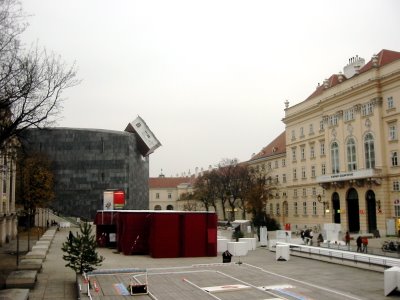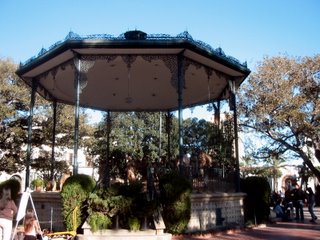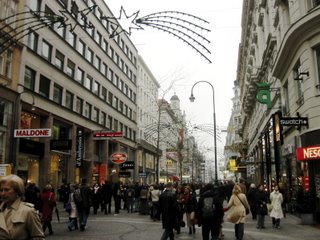
The new MOMUK in the Museum Quarter
YOU TAKE THE BUS 48A here at the Dr. Karl Renner Ring, said the helpful lady at the Information office, and you ride it to the end of the line, and then you walk. It’s rather far.
We use information offices a lot. My favorites are the VVV offices in The Netherlands; there’s one in just about every town in the country, and they’re well supplied with information — though only for their own town.
In France it’s the Syndicat d’Initiative, or was; we haven’t toured in France for years. The name means simply Chamber of Commerce, but I like its assumption that a little initiative will be on display; and frequently it is.
In Italy there are Turismo offices in most of the cities we’ve been to. There was a fine office in Budapest, where a young man spoke fine English but no Hungarian at all, because he was from Spain. Thus does Brussels, one of the capitals of the European Community, normalize staffing in this recently integrated subcontinent.
In spite of its size and its dependence on tourism, Vienna seems to have only the one office, on the Albertinaplatz across the street from the Staatsoper. Nor does there, at least on grey days in November, seem to be much demand for it: we always step right up to a window for assistance from one of the bright and pretty young women, who always speak perfectly fluent English.
(The men are off doing more important things, I suppose; or behind the scenes, administering. Vienna, which has been a capital city for a thousand years, relies heavily on administration for the employment of her citizens.)
Getting about in Vienna has been simple, particularly since it hasn’t been raining. We walk most places, since our apartment is within the inner city, and many of the streets are pedestrianized. But we’re only five minutes or so from the Ring, with its trolleys tirelessly circling the inner city every five minutes or so, one clockwise and one counter-clockwise. We’re even closer to a Metro station, and they also run frequently.
Then there are a couple of mini-bus lines within the inner city; one stops a block from our front door. Their routes seem rather circuitous, and well they might be, for they must snake their way through a network of pedestrian streets, one-way streets, narrow alleys, and
Platzen — for like all European cities Vienna has a liberal sprinkling of open spaces devoted to conversation, temporary markets, photo-taking, and a little bit of parking.
Platzen, places, pleins, piazzas, plazas; the effect in all these cities is to open things up a bit, often in an unanticipated place, letting in sun (or rain), lending a bit of distance and perspective to one’s view of facades and towers, and reminding one that there are people in cities, that cities are, as someone memorably said, for people.
Of course these openings date from pedestrian days; these cities evolved without motor vehicles. They also represent cultures whose take on real-estate value, and the very purpose of social space, is not like the take prevailing, it seems to me, in the United States. Of course we have our public spaces too; Healdsburg with its formerly central Plaza and Manhattan with its downtown Squares testify to that at two different extremes; but our public spaces are both fewer and more closely regulated. And as our cities decay, too often these spaces are simply parking lots, for large expanses of the American city are not for People at all, but for Cars.
WELL: WE TOOK THE BUS out to the end of the line, yesterday evening, leaving home about six-thirty, lazing our way to Dr. Karl Renner Ring via foot and tram, and then riding all the way out to Baumgarten. As the bus drove out, the city grew more drab. There was more motor traffice, even though the Neustiftgasse is not a very wide street. (
Gasse means, roughly, small street, or even lane or alley; the more usual German word
Strasse would indicate what we think of as a normal two-way steet.)
Cars and bicycles sped past our bus when it was stopped, for whatever reason, often only inches from our window. More often it was we who sped past them, for buses and taxis have lane privileges. The storefronts and eateries offered progressively less upscale material, less for tourists, more for locals. The paving was smooth asphalt, not cobblestone. We were almost imperceptible climbing, west, away from the Danube, across what was for centuries fertile river-plain at the base of the hills bordering the citie with their famous Vienna Woods.
From time to time the vista opened further as we crossed wide railroad yards, I suppose, or other trafficways, on viaducts. At one point we were surpised by a soccer field, tucked away and a little lower and secure behind a high wall, but given away by its clusters of lights, and finally revealed, when we came to the end of it and took a slight curve: a couple of teams, amateurs playing without an audience, were in what seemed to me to be rather listless activity.
Suddenly there was an enormous building promising tennis, handball, saunas, exercise; and next to it the Merkur complex of shopping mall and discount stores: we were well into the suburbs. And then it grew darker, the street was bordered on one side by trees, on the other by a low dull-grey cement wall that seemed endless, pierced only at considerable intervals by driveways.
The bus had started out full, but there were now only a few people left. Some of us were clearly going to a concert, I thought; others were oddly talking quite loud, or making nuisances of themselves in some other way. They were behind me and I didn’t turn to see what was going on: drunks, I imagined.
The bus stopped at one of those driveways, next to a sign identifying the place as a psychiatric hospital, and the obstreperous riders crowded good-naturedly out onto the sidewalk. Patients out on leave, I thought, or perhaps visiting even less fortunate friends who are inside somewhere.
Further on most of the rest of the passengers got out at another hospital, but we did not: this was not the end of the line; there was one stop more. There of course we did get out, with one other person who quickly disappeared. There wasn’t much to see in the dark — one lone building with lights on a few meters away, a roadhouse of sorts. I asked the bus driver where the Jugendstil Theater was, but could not understand his reply, which came in an impatient Austrian dialect.
At the roadhouse no one spoke English. The cook-bartender, harried and suspicious, seemed to say that it was back in the direction we’d come from, but I couldn’t be sure. Still, there was nowhere else to go, so we started walking up the street.
BEFORE LONG WE CAME to a gate with a guard-porter in his little office. He signed and turned down his television set when I asked if he spoke English. Nein, he said, and began to turn the thing back up again.
Kennen Sie wo is der Jugendstil Theater, I asked in my limping German, and he responded almost comprehensibly: up there (gesturing), five hundred meters, on the left, go in at the big doors.
I counted the paces, for my pace is just about a meter, and sure enough at five hundred there we were back at the next-to-last bus stop where a number of people had got off the bus. People were milling around uncertainly, then for no apparent reason heading up the driveway into the dark. I was reminded of the big flocks of chimney-swifts we watched a month or so ago, milling and wheeling in the dusk, then for no apparent reason all flying, first a few at a time and then
en masse, into the chimney of a building at the Seventh-Day Aventist Acadmy outside Healdsburg.
We were not flying; we were walking purposefully, curving left to walk around the large building this gateway served — sure enough, a hospital — and then we came upon a bed of white plastic tubes with small yellowish lights in them at the bottom, set a foot apart or so in a grid of what must have been hundreds of torches — a permanent installation or a temporary one? No idea.
And then we were at the Jugenstil Theater in what I learn this morning is the Otto Wagner Spital: presumably it was Wagner who designed it, in his famous end-of-19th-century pre-Cubist style. It was the setting for a concert by the Kronos Quartet, who played Terry Riley’s
The Cusp of Magic, an intricate 45-minute suite of six movements involving prominent parts for the Chinese
pipa (effectively played by Wu Man, who also sang enchantingly) and, in one movement, a collection of children’s toys, whose sounds merge with pre-recorded toy sounds, and voices.
At one particularly magic moment, in the third movement (“The Nursery”), Riley’s music slowly disappears altogether; music and the art of music merge imperceptibly into the music of unseen human voices and activity. The fifth movement, “Emily and Alice,” returns to this quality in a particularly moving and absorbing texture, this time returned to the familiar textures of the string quartet — sonic textures I always think of as quintessentially Viennese, since it was here that Haydn, Mozart, Beethoven and Schubert defined the norms.
After intermission we heard Henryk Górecki’s third quartet, written ten years ago but only released by the composer last year — one doesn’t know why, for certain; but it’s clearly a valedictory message, nearly an hour of extremely slow music (though the central of the five movements moves a little more quickly), beginning with the insistent rhythm of Schubert’s “Death and the Maiden” slow movement and growing steadily more somber from there.
I don’t know when I’ve heard Kronos play so beautifully, with such refined tone, with such impeccable intonation, with such precise but purely felt ensemble. The music was enhanced by very subtle plays of colored light, so subtle one might easily have ignored it altogether. The audience, quite full, was riveted; hardly a cough or a rustle to be heard in fifty-five minutes of concentration.
To my taste the effect was damaged by an encore based on an Icelandic rock group — I surmise from the strident distortion and reverb applied electronically to the quartet — but no one else seemed to mind, and the first violinist, David Harrington, even explained that Ligeti himself was inspired on hearing it after his own music.
And then the trip back. I’ve been struck by the rudeness of the young Viennese: they crowd in front of you in queues; they do not yield seats to old ladies; they slump in streetcar seats, monopolizing foot-room and even sitting in two places when people are standing. The concept of public space seems not to have handed down to the generation under, say, thirty.
This was particularly striking given that many of these people had just heard the same inspired, transcendent concert, a program clearly addressing the poignancy of human interrelationships — “intercourse,” it used to be called, until that word became pre-empted by too specific a meaning — in a world of too many people grown increasingly too self-absorbed. It’s one of the sub-themes of this Festival of “New Crowned Hope,” and Vienna, with its eternal juggling of traditions and rebellions, invention and politesse, City and Empire is a uniquely appropriate place to consider it.


















